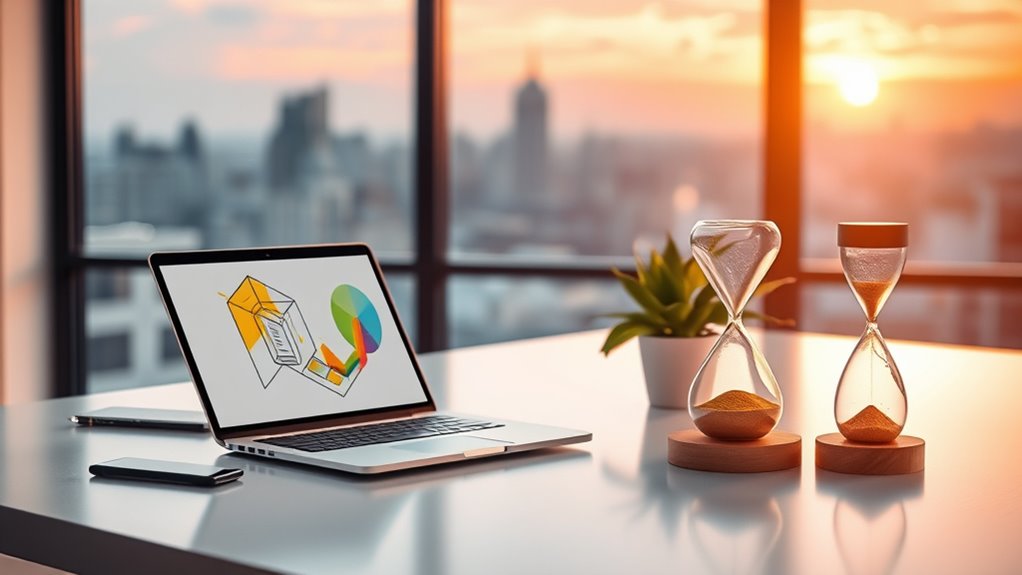Using timeboxing in your creative process turns constraints into powerful tools for focus and innovation. When you set strict time limits, you break through mental blocks, prioritize ideas, and avoid aimless wandering. Constraints encourage you to think more intentionally and explore ideas freely within boundaries. This approach sharpens your output and prevents perfectionism. Keep exploring, and you’ll discover how boundaries can truly become your creative assets.
Key Takeaways
- Constraints focus your attention, encouraging deeper exploration and preventing aimless wandering during creative sessions.
- Timeboxing transforms chaos into structured breakthroughs by setting clear limits, enhancing productivity and idea quality.
- Imposed boundaries stimulate innovation by challenging you to think within manageable, focused parameters.
- Using time limits helps avoid perfectionism, enabling quick idea generation, evaluation, and refinement.
- Flexible constraints serve as creative assets, fostering intentional thinking and efficient workflow without stifling originality.

Timeboxing creativity is a powerful way to break through mental blocks and boost your productivity. When you set strict time limits for your creative sessions, you force yourself to focus and prioritize your ideas. This method is especially effective when you’re trying to overcome endless brainstorming techniques that can sometimes lead to overwhelm or paralysis. Instead of letting your mind wander aimlessly, you create a structure that encourages intentional thinking. By defining clear boundaries, you give yourself permission to explore ideas within a set frame, which can actually enhance your creativity rather than stifle it.
Setting strict time limits transforms chaos into focused, creative breakthroughs.
Creative boundaries are often misunderstood as restrictions that limit your potential. In reality, they serve as catalysts for innovation. When you impose constraints, you’re not shutting down ideas; you’re sharpening your focus. Timeboxing helps you avoid the trap of perfectionism or endless editing, which often kills momentum. Instead, it pushes you to generate a manageable number of ideas, evaluate them quickly, and move forward. This process keeps your creative energy flowing and prevents you from getting bogged down in details prematurely. As you work within these boundaries, you learn to leverage your brain’s natural tendency to think more creatively when given clear limits. Additionally, understanding the impact of constraints on your cognitive processes can help optimize your creative workflows.
Using timeboxes also encourages you to experiment with different brainstorming techniques. For instance, you might dedicate one session to rapid idea generation, where you jot down as many concepts as possible without judgment. Another session could focus on refining and connecting ideas within a fixed time frame. By cycling through these approaches, you keep your creative process dynamic and engaging. The key is to view timeboxing not as a cage but as a flexible container that guides your thoughts and helps you stay on track. When you set a timer, you’re more likely to stay engaged and avoid distractions, which often sap your mental energy during open-ended thinking.
Ultimately, this method transforms your approach to creativity from open-ended chaos to a disciplined pursuit. You learn to balance freedom with focus, harnessing constraints to generate more meaningful ideas. Timeboxing doesn’t kill your creativity—it channels it. When you embrace creative boundaries and set deliberate time limits, you’ll find that your ideas become sharper, your productivity increases, and your overall creative process becomes more intentional. With practice, you’ll discover that working within these boundaries *unlocks* a surprising amount of innovation, turning constraints into your greatest creative assets. Recognizing how the weight of wind turbine blades varies based on design and materials exemplifies how constraints can influence performance and efficiency.
Frequently Asked Questions
How Do I Choose the Right Timebox Length for Creative Tasks?
You should set appropriate durations based on the complexity of your creative task. Start with short timeboxes, like 15-30 minutes, and adjust as needed. Balance flexibility by allowing some extra time for ideas to develop, but avoid extending too long, which can cause loss of focus. Experiment with different lengths to find what sparks your creativity while maintaining productivity and momentum.
Can Timeboxing Stifle Spontaneous Ideas During Brainstorming Sessions?
Timeboxing can limit spontaneous inspiration if you’re too rigid, but it doesn’t have to cause idea suppression. When you set flexible time limits, you give yourself space to capture fleeting thoughts without derailing the session. By balancing structure with openness, you encourage spontaneous ideas to surface naturally. Remember, the goal is to harness focus, not stifle creativity, so adjust your timeboxes to allow room for unplanned inspiration.
What Tools Are Best for Implementing Timeboxing in Creative Workflows?
You can effectively implement timeboxing in creative workflows with digital timers and project management tools. Studies show that teams using these tools boost productivity by 25%. Digital timers help set clear limits, keeping ideas focused, while project management platforms like Trello or Asana organize tasks within timeframes. These tools create a structured environment that fosters creativity without overwhelming, ensuring you stay on track while exploring innovative ideas.
How Do I Handle Deadlines That Conflict With Creative Exploration?
To handle conflicting deadlines and maintain creative freedom, prioritize balancing deadlines by breaking projects into smaller, manageable timeboxes. Allocate specific periods for exploration and stick to them, ensuring you don’t sacrifice creativity for speed. Communicate openly with stakeholders about realistic timelines, and be flexible when needed. This approach helps you meet deadlines without stifling innovation, fostering a productive environment where creativity thrives within constraints.
Is Timeboxing Suitable for Collaborative Creative Projects?
Research shows teams that use structured timeboxing improve their productivity by 25%. Timeboxing works well for collaborative projects because it fosters team alignment and encourages focused idea sharing. By setting clear time limits, everyone stays on the same page, making it easier to develop ideas without losing momentum. It’s a practical way to balance creativity and deadlines, ensuring your team stays innovative while meeting project goals efficiently.
Conclusion
By embracing timeboxing, you harness constraints as your secret weapon, turning chaos into clarity. When you set strict limits, you release a burst of focus so powerful it can rival a rocket launch—propelling your ideas faster and sharper than ever before. Don’t fear constraints; use them to ignite your creativity and transform how you work. With timeboxing, you’ll discover that limits aren’t barriers—they’re the rocket fuel for your most extraordinary ideas yet.








